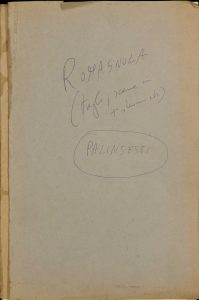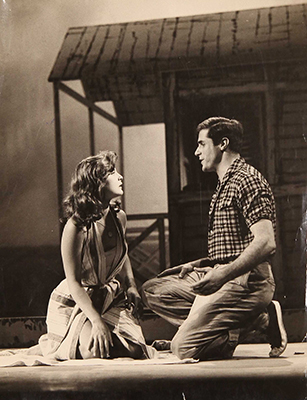Debutto: Roma, Teatro Valle, 5 febbraio 1959 (filmato RaiTeche)
| Regia | Luigi Squarzina |
| Regista assistente | Renzo Frusca |
| Scene | Gianni Polidori |
| Costumi | Misa D’Andrea |
| Musiche | Angelo Musco jr. |
| Produzione | Teatro d’Arte Italiano (Carlo Alberto Cappelli) |
Personaggi e interpreti
| I quattro suonatori | Sergio Notaro Luciano Bontempi Orio Fanelli Francesco Santucci |
| Domenica | Zora Piazza |
| Cencio | Franco Graziosi |
| Il torci | Renzo Palmer |
| Cecilia | Virna Lisi |
| Michele | Carlo Giuffrè |
| Il conte Gardenghi | Claudio Gora |
| Guelfo | Franco Parenti |
| Savelli, poi “il nero” | Vittorio Sanipoli |
| Cantoni, il fattore | Armando Bautti |
| Pachino, capo bracciante, poi “rico” | Luigi Geminiani |
| Silvio, suo figlio, poi “eolo” | Franco Casaretti |
| Tonino | Umberto Ceriani |
| Fausto | Gianluca Francisci |
| Iris | Esperia Pieralisi |
| Il federale | Mino Doro |
| Il vice federale | Corrado Nardi |
| Il console della milizia | Loris Gizzi |
| Marisa | Paola Dapino |
| Donna Casimira | Laura Adani |
| Un critico anziano | Corrado Sonni |
| Un giovane del GUF, poi “il commissario” | Paolo Giuranna |
| Un altro giovane del GUF | Roberto Muratori |
| Il maggiore medico | Leonardo Severini |
| Il tenente medico | Mario Lombardini |
| 1° richiamato | Fernando Cerulli |
| 2° richiamato | Emilio Girola |
| L’ammiraglio | Armando Migliari |
| 1° ufficiale di marina | Giamberto Marcolin |
| 2° ufficiale di marina | Quinto Parmeggiani |
| Gavinana | Luca Ronconi |
| Un furiere della gnr | Pierluigi Costantini |
| Un volontario, poi 1° milite | Nino Filippini |
| 2° milite | Claudio Dani |
| Delegato p.l.i. | Tullio Boschi |
| Delegato p.s.i.u.p. | Luigi Geminiani |
| Delegato d.c. | Fernando Cerulli |
| Delegato g.l., poi “zeta” | Quinto Parmeggiani |
| Delegato p.r.i. | Carlo Baroni |
| Osservatore monarchico, poi “falco” | Corrado Sonni |
| Osservatore anarchico | Igino Zangheri |
| “sante” | Calisto Calisti |
| “ferro” | Rino Bolognesi |
| “fattirob” | Auro Franzoni |
| “nord” | Mario Lombardini |
| Un partigiano toscano | Roberto Muratori |
| Il generale italiano, maresciallo d’Italia | Sergio Tofano |
| Il generale tedesco | Leonardo Severini |
| Serena | Mirella Rizzi |
| Il prete | Giamberto Marcolin |
| L’arciprete | Armando Bautti |
| Il medico condotto | Tullio Boschi |
| La donna | Lidia Bonetti |
| La ragazza | Luisiana Berti |
| La bambina | Manuela Tomassini |
Scritta tra il 1951 e il 1957, è una kermesse divisa in tre parti, a loro volta ripartite in giornate, ogni giornata in scene, senza limiti di tempo e di luogo. La successione delle scene trova la sua unità nei protagonisti, nel ritmo incalzante e nella molteplicità delle vicende tra loro connesse di ispirazione scespiriana, riscontrabile anche nell’uso di cartelli per indicare la data delle giornate. Ma nella commedia c’è anche Brecht: nelle riflessioni critiche sul contesto delle vicende, nella descrizione delle stesse, negli ammonimenti didascalici, nei canti, che introducono le singole giornate; nella esplicitazione della finzione teatrale dei suonatori che imitano il rumore dei carri o delle motociclette o il suono dell’altoparlante di spiaggia o delle sirene. I dialoghi, aspri o concitati, ironici o passionali, sempre essenziali, oltre ad esprimere caratteri e stati d’animo, collocano la tragica storia d’amore dei due protagonisti, Cecilia, uccisa dai partigiani perché ha denunciato Michele, e Michele, ucciso dai fascisti perché partigiano, nella più grande storia della Romagna contadina e della sua partecipazione collettiva alla Resistenza.
La commedia, infatti, racconta le vicende che vanno dal 28 giugno 1942 all’11 aprile 1945, portando in scena ottanta personaggi. Squarzina con Romagnola vince il Premio Marzotto 1957. In un passo della motivazione si legge: “Non v’è dubbio che il suo dramma presenta pregi di originalità e di validità letteraria, d’invenzione scenica e di audacia ideologica che difficilmente si potrebbero riscontrare in chi del teatro non abbia la padronanza tecnica e quel senso di profonda responsabilità ideale che impegna tutte le facoltà dell’uomo di teatro alla manifestazione del proprio mondo attraverso la più minuta conoscenza del mezzo col quale si esprime”.
 “In questo senso il mio lavoro voleva rappresentare la crisi della civiltà contadina; nelle campagne nulla poteva essere più come prima. I rapporti di potere tra proprietari, mezzadri e braccianti risalgono a prima della Resistenza, è una conflittualità di altro tipo. Molte cose di quelle che racconta il Sangue dei vinti di Pansa in Romagna si spiegano con quello che era successo prima, perché, a parte vent’anni di fascismo, erano rapporti interni al sistema del patronato e della condizione agricola ed erano connotati dalla violenza e dallo sfruttamento”.
“In questo senso il mio lavoro voleva rappresentare la crisi della civiltà contadina; nelle campagne nulla poteva essere più come prima. I rapporti di potere tra proprietari, mezzadri e braccianti risalgono a prima della Resistenza, è una conflittualità di altro tipo. Molte cose di quelle che racconta il Sangue dei vinti di Pansa in Romagna si spiegano con quello che era successo prima, perché, a parte vent’anni di fascismo, erano rapporti interni al sistema del patronato e della condizione agricola ed erano connotati dalla violenza e dallo sfruttamento”.
Luigi Squarzina
Tratto da E. Testoni, Dialoghi con Squarzina, Firenze, Le Lettere, 2015, p. 113
Le prove dello spettacolo
Il servizio Rai

